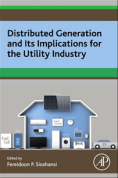 Distributed Generation and its Implications for the Utility Industry Published by Elsevier in July 2014, 552 pp, $120.00/£73.00, ISBN: 9780128002407.
Distributed Generation and its Implications for the Utility Industry Published by Elsevier in July 2014, 552 pp, $120.00/£73.00, ISBN: 9780128002407.
Understand the technological, business, and regulatory strategies that will keep utilities viable in the emerging age of distributed energy generation.
To buy the book, click here. Use discount code PRT314 on checkout for a 30% saving.
Reviews
Wolfgang Pfaffenberger in Energy Research & Social Science. Click here to read (PDF).
Key Features
- Discusses the technological, business, and policy trends most impacting the electric utility sector
- Provides an assessment of how fast and how soon distributed energy resources may make an impact on utility sales/revenues
- Explores, through a series of international case studies, the implementation of strategies that may help retain the viability of the utility industry
- Features contributions from a number of scholars, academics, experts and practitioners from different parts of the world focused on examining the future of the electric supply industry
Description
Distributed Generation and its Implications for the Utility Industry examines the current state of the electric supply industry; the upstream and downstream of the meter; the various technological, business, and regulatory strategies; and case studies that look at a number of projects that put new models into practice.
A number of powerful trends are beginning to affect the fundamentals of the electric utility business as we know it. Recent developments have led to a fundamental re-thinking of the electric supply industry and its traditional method of measuring consumption on a volumetric basis. These developments include decreasing electricity demand growth; the rising cost of fossil fuels and its impact on electricity costs; investment in energy efficiency; increasing numbers of prosumers who generate for some or all of their own needs; and market reforms.
This book examines the implications of these trends in chapters focusing on distributed and decentralized generation, transactive energy, the role of electric vehicles, any much more.
Table of Contents
- Foreword – Urban Keussen, E.ON
- Preface – Ralph Cavanagh, NRDC
- Introduction – Fereidoon Sioshansi, Menlo Energy Economics
- Part I: What is changing?
- Chapter 1 Decentralized energy: Is it as imminent or serious as claimed? – Fereidoon P. Sioshansi, Menlo Energy Economics
- Chapter 2 New utility business model: A global view – Paul Nillesen, PwC, The Netherlands, Michael Pollitt, Judge Business School, Cambridge, UK and Eva Witteler, PwC, Germany
- Chapter 3 Germany’s decentralized energy revolution – Christoph Burger and Jens Weinmann, European School of Management & Technology, Berlin, Germany
- Chapter 4 Australia’s million solar roofs: Disruption on the fringes or the beginning of a new order? – Bruce Mountain and Paul Szuster, Carbon + Energy Markets
- Chapter 5 As the role of the distributor changes, so will the need for new technology – Clark Gellings, EPRI
- Chapter 6 The impact of distributed generation on European power utilities – Koen Groot, Clingendael Energy
- Chapter 7 Lessons from other industries facing disruptive technology – Fereidoon Sioshansi, Menlo Energy Economics with contribution from Carl Weinberg, former head of R&D at PG&E
- Part II: Implications and industry/regulatory response
- Chapter 8 Electricity markets and pricing for the distributed generation era – Malcolm Keay, John Rhys and David Robinson, Oxford Inst. for Energy Studies
- Chapter 9 Transactive energy: Linking supply and demand through price signals – Chris King, Siemens
- Chapter 10 Transactive energy: Interoperable transactive retail tariffs – Edward Cazalet, TeMix Inc.
- Chapter 11 The evolution of the electric distribution utility – Philip Hanser and Kai van Horn, The Brattle Group
- Chapter 12 An expanded distribution utility business model: Win-win, or win-maybe? – Timothy Brennan, UMBC & Resources for the Future (RFF)
- Chapter 13 From throughput to access fees: The future of network and retail tariffs – Tim Nelson, AGL, Judith McNeill Univ. of New England, Armidale and Paul Simshauser, AGL
- Chapter 14 Industry response to revenue erosion from solar PVs – Jonathan Blansfield and Kevin Jones, VT Law School
- Chapter 15 Making the most of the no growth business environment – Ahmad Faruqui, The Brattle Group and Dian Grueneich, Dian Grueneich Consulting, LLC
- Chapter 16 Regulatory policies for the transition to new business paradigm – William Miller, LBL, Roland Risser, US DOE and Steven Kline, Sustainability & Policy Consulting
- Chapter 17 Electric vehicles: New problem, or distributed energy asset? – Glenn Platt, Phillip Paevere, Andrew Higgins, and George Grozev, CSIRO, Australia
- Part III: What future?
- Chapter 18 Rethinking the transmission-distribution interface in a distributed generation future – Lorenzo Kristov and Delphine Hou, CAISO
- Chapter 19 Decentralized generation in Australia’s National Electricity Market? No problem – Rajat Sood and Liam Blanckenberg, Frontier Economics
- Chapter 20 What future for the grid operator? – Frank Felder, Rutgers University
- Chapter 21 Utility version 2.0: Maryland’s pilot project – Dustin Thaler and John Jimison, Energy Future Coalition
- Chapter 22 Turning a vision to reality: Boulder’s utility of the future – Kelly Crandall, Heather Bailey, Yael Gichon and Jonathan Koehn, City of Boulder, CO
- Chapter 23 Perfect storm or perfect opportunity? Future scenarios for the electricity sector – Jenny Riesz, UNSW, Magnus Hindsberger, AEMO, Joel Gilmore, ROAM Consulting, and Chris Riedy, UTS, Australia
- Chapter 24 Evolution, revolution or back to the future: Lessons from the electricity supply industry’s formative days – Robert Smith, Ausgrid and Iain MacGill, UNSW
- Epilogue Jon Wellinghoff, former chairman of FERC

